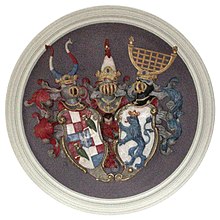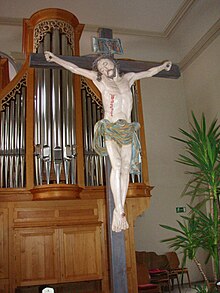St. Cyriakus (Dürnau)
The Church of St. Cyriakus and St. Kilian is the oldest church in Dürnau in the district of Göppingen .
Building
The building dates from the Gothic period and was expanded in 1583. In 1649 Christoph Martin von Degenfeld had the heavily damaged castle rebuilt and the church renovated. The Kiesersche forest map from 1683 shows the Cyriakskirche with a three-part tower (height: 31 m) with an octagonal spire.
The weather vane consists of a star and a crescent, a symbol that can be found on many church towers in southwest Germany and, contrary to legend, is almost certainly not a trophy from the war against the Turks on behalf of the Republic of Venice.
The rectangular interior, which was renovated in the 1960s, has five entrances. Traces of the colored stucco work from the late Renaissance period are preserved, as are remains of Gothic wall paintings. Today the epitaphs of the Zillenhardt Knights are on the left wall under the northern gallery ; originally they were kept lying in the eastern part of the church. They are made of sandstone, traces of the originally colored version can still be seen. Lined up from right to left are the epitaphs of Wilhelm II von Zillenhardt , who died in 1530, Hans Wolf von Zillenhardt , a civil servant in the Württemberg service, who saved Stuttgart from destruction by fire in 1546 through his negotiating skills and died in 1557, Wolfgang von Zillenhardt , who tried to settle the family of the Jew Lazarus in Dürnau, and from the last male Zillenhardt Wolf Niklas , with whom the line went under in 1623. The epitaph of the ten-year-old noble boy Wilhelm, who died in 1577, and that of Friedrich Jakob von Anweil can also be seen. It is located between those of Wilhelm II and Christoph Martin, because next to the sandstone epitaphs there is another epitaph made of red marble. It is dedicated to Christoph Martin von Degenfeld and was donated by three of his sons. Presumably it was designed by an Italian artist. It shows the allegorical figures Minerva , Concordia and Caritas as well as the coats of arms of the sword fields and those of Adelmannsfelden.
These coats of arms can be found again on the ceiling of the church, united in an alliance coat of arms of Christoph Martin von Degenfeld and his wife von Adelmannsfelden. A silver eagle has been in the Degenfeld coat of arms since Christoph Martin's elevation to baron status in 1625. The crowned green parakeets come from the time of Christoph von Degenfeld, who took them from the coat of arms of his wife Barbara von Stammheim. The head of the male figure, which peeks out between the two heart-shaped coats of arms, is uninterpreted. A blue soaring lion with two tails is part of the coat of arms of the von Adelmannsfelden. Buffalo horns serve as the crest on the Degenfeld coat of arms, while the Adelmannsfeldeners have half a golden sieve with ostrich feathers.
During the renovation of the church in 1967, the old wall paintings were exposed. They come from z. Some of them date from around 1500 and were partially destroyed by the installation of the count's stand in 1617. Image fields, which are best viewed from the northern gallery, show scenes from the life of Jesus in the upper row. The twelve-year-old Jesus in the temple, Jesus in Nazareth and the wedding in Cana can still be recognized . The first four commandments are illustrated in double images in the lower row . The depiction of a she-devil, which is so rare to find, is interesting. The church's crypt was filled in during renovations in the 1950s .
Peal
Today the church of St. Cyriak has a bell with the tones fgb. The large bell with a weight of approx. 900 kg was cast in Stuttgart by Carl Fridrich Blüher in 1786 after it had cracked. It was removed from the tower for remelting during World War II . Fortunately, however, this destruction did not take place and the bell was discovered by chance in Hamburg in 1947 and brought back to Dürnau. The middle bell was melted down during the First World War . Her successor, donated by a Swiss citizen in 1928, suffered this fate during World War II and was replaced in 1969. The small bell was cast in 1849 and recast in the course of the church renovation in 1968/69.
Organs
From 1716 to 1880 an organ , built in 1616, was used in the St. Cyriakskirche , which then had to give way to an instrument made by Johann-Georg Schäfer from Göppingen . This shepherd organ was housed in the eastern gallery of the church and was transferred to the count's status in 1997 when the new organ, Regina Nova, was installed. The Schäfer organ has 16 stops on two manuals and a pedal . The playing and stop actions are pneumatic
|
|
|
||||||||||||||||||||||||||||||||||||||||||||||||||||||||||||||||||||||||||||||||||||||||||||||
- Coupling : II / I, II 16 '/ I, I / P, II / P
- Playing aids : Fixed combinations (p, mf, tutti), general coupling
In 1992 a new organ was built by the Scharfe organ building workshop (Bünzwangen). The new "Regina Nova" organ has 17 registers (1000 pipes ) and a Zimbelstern .
History and denominations
A church in Dürnau - at that time still "Durnon" - is mentioned for the first time indirectly in 1275 in a listing of the defaulting taxpayers of the diocese of Constance. At that time, money was collected for a crusade that had been decided at the Synod of Lyon in 1245. However, it can be assumed that a church or chapel existed in Dürnau before 1275.
Around 1150 the pilgrim brotherhood of St. Matthias carried out a pilgrimage from Gammelshausen or Boll to Trier ; The initiator was probably Berta von Boll . The first patronage in Dürnau, St. Cyriakus, goes back to them. The second, St. Kilian, probably dates from the Staufer period.
Since 1358 the Dürnau church has been under the patronage of Adelberg, which was reformed in 1535. But Dürnau initially remained Catholic. It was not until 1543 that the first farmers were allowed to attend the Reformed church service in Boll and in 1545 the first Protestant pastor, Johann Ulrich Löblin, was appointed to Dürnau. However, he did not stay long because of the poor economic conditions, so that Dürnau became Catholic again for an interim period from 1549 to 1572. In 1623 the male line of the lords von Zillenhardt died out and Dürnau passed to the Degenfelder. In 1682, Hannibal von Degenfeld drove the evangelical pastor Johannes Schrötlein out of the community and threatened him with death. He donated inventory for Catholic worship and had the church choir cordoned off for the sole use of Catholics. The rest of the church remained open to both denominations. The previously independent evangelical parish of Dürnau became a branch, which was looked after alternately from Lotenberg and Uhingen . In 1711, however, a court judgment ruled that Hannibal's sale of the entire Dürnau / Gammelshausen manor to Bavaria in 1684 had not been lawful. Half of the property therefore went back to the Degenfeld family (in 1770 the Degenfelders were also able to buy back the other half from Bavaria), whereupon a Protestant pastor could be created again. From this point on, St. Cyriakus was equally available to both denominations. The crucifix in the church interior dates from this time. It was created by a Bartholomäus Riegger, probably a grandson of Balthasar Riecker , in Schwäbisch Gmünd and painted by the painter Hans Jacob Hayd from Salach.
In 1804, the increasingly smaller Catholic community in Dürnau lost its last clergyman with the departure of the Capuchins . Twenty years later she sold the altar, which dates back to Hannibal's action in 1682, to the evangelical community and built a neo-Gothic altar of her own on the north side of the church. This “Catholic altar” was in St. Cyriakus until 1964. Then it was dismantled by the Catholic young men in a night-and-fog operation. Today it is housed in the tower of St. Michaelskirche, which was built after the Catholic community had grown again after the Second World War due to the influx of displaced people .
Faith disputes and non-Christians in Dürnau
The Jew Lazarus
In 1582, Wolfgang von Zillenhardt allowed a Jewish family whose head was called Lazarus to stay in Dürnau for an annual payment of 25 guilders. However, complaints soon arose from the population that Lazarus had to give up their poor house, and the Württemberg Duke Ludwig von Wolf , to the delight of the village priest at the time, Georg Eninger, ordered the "abolition of the Jews", about whose further fate nothing is known. The case was resumed by Nazi propaganda in 1942.
The Turkish Anna Dorothea newborn
A girl who originally believed in Islam and who was brought back from his Balkan campaigns by Christoph Martin von Degenfeld in 1649 was more careless. It was baptized under the name Anna Dorothea Neugeborin in 1651, presumably in the castle, first mentioned as godmother in 1665 and married a local widower with six children in 1667. Anna Dorothea not only raised these children, but also eight of her own, whom she gave birth to to her husband Christoph Demmerer. She died in 1692.
Württemberger and Degenfelder - Church dispute 1671
Christoph Martin's eldest son, Ferdinand the Blind , demanded in 1671 that at the end of every service in Gammelshausen a prayer should be said for his family, but not for that of the Duke of Württemberg. However, since the clergy were under the patronage of the Duke in Stuttgart, they defended themselves against this request and a church dispute broke out, which came to a head until all services were canceled and the church closed on Pentecost 1672. Ferdinand threatened with armed force if this ban on worship was not complied with, but gave in in 1674 and allowed services to be held again if neither of the two gentlemen was prayed for.
See also
literature
- Claus Anshof : Three churches, two parishes. Dürnau - Gammelshausen . 2006
- Claus Anshof: Dürnau - Gammelshausen, ten stations in local church history. (Which is not in the church guide) . 2006
Individual evidence
- ↑ a b c d e History and pictures of the church on the parish homepage, accessed on April 20, 2016
- ↑ Organ of the cath. Church - Dürnau. Archived from the original on October 6, 2013 ; accessed on October 8, 2014 .
- ^ Dürnau, Germany (Baden-Württemberg) - Sankt Cyriakuskirche. Organ database NL. Retrieved November 20, 2015 .
Web links
Coordinates: 48 ° 38 '30.2 " N , 9 ° 38' 8.4" E










